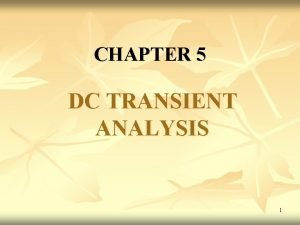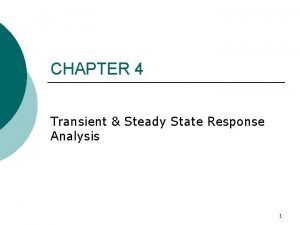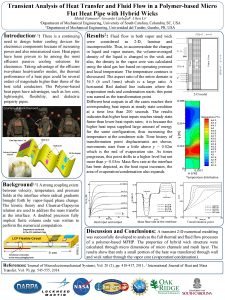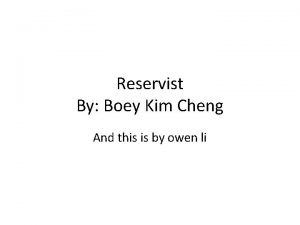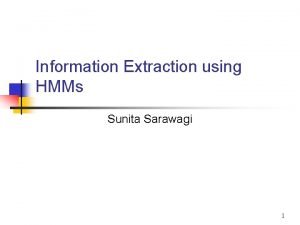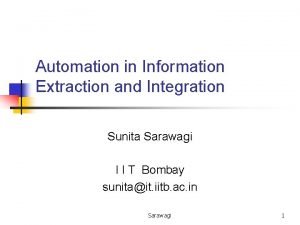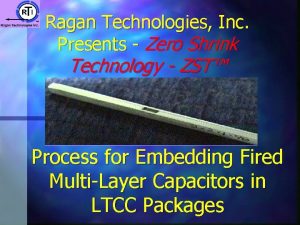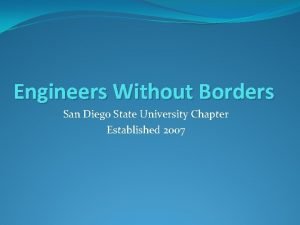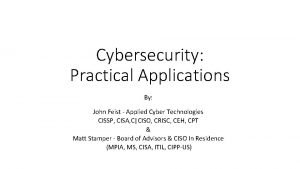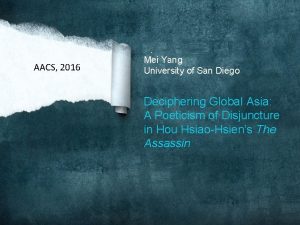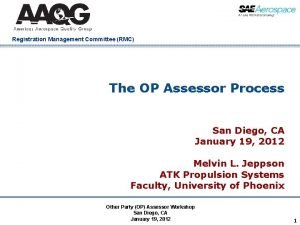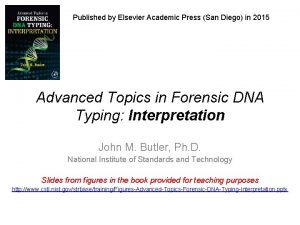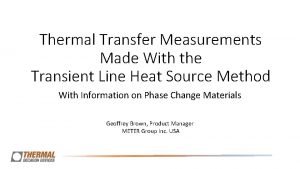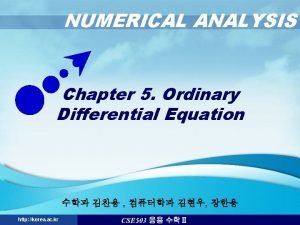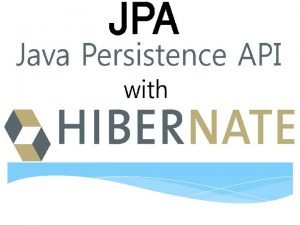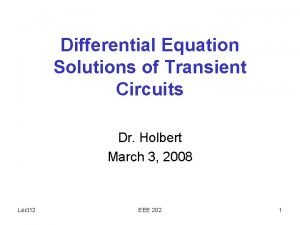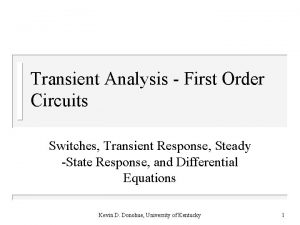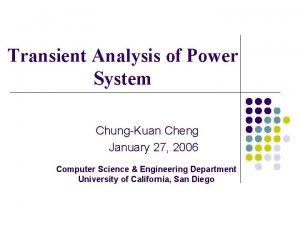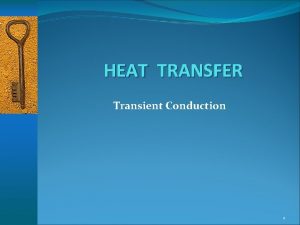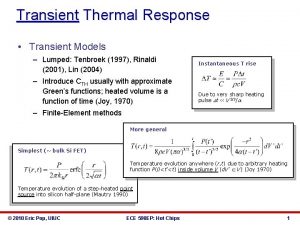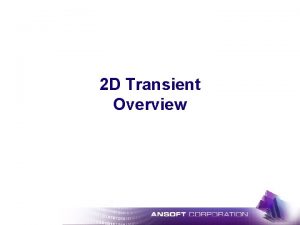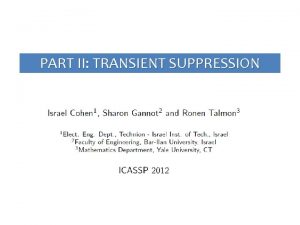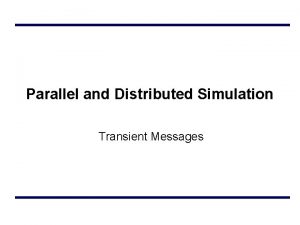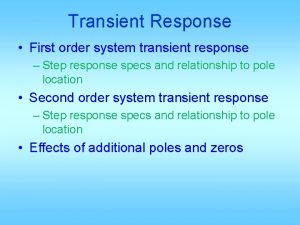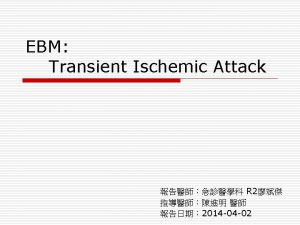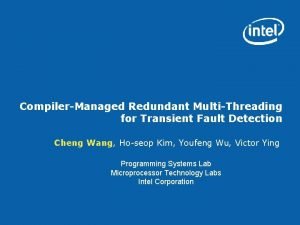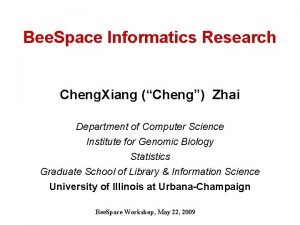Transient Analysis CK Cheng UC San Diego Jan


























































- Slides: 58

Transient Analysis CK Cheng UC San Diego Jan. 25, 2007

Outline • • • Research Directions Simulation test case results Overview of Simulation Commercial Package Alternating direction implicit (ADI) Method • General Operator Splitting Method • Distributed Computing • Conclusions and Future Works

Research Directions • • Simulation: SPICE, STA Network on Chip: topology and wire styles, Power, and Clock Networks Data Path Components: adders, shifters, multipliers, division • Packaging: passive distortion compensation

6 x 6 Bump Simulation Results • The Circuit: – 184 K Capacitors, 17 K Current Sources, 120 K Inductors and 246 K Resistors. – 306 K Nodes • Accuracy: – Waveform and measurement results match Fujitsu’s with less than 0. 002% error. • Runtime / Memory Comparison: CPU_Time Memory Computer Used UCSD 678 s 600. 2 M Pentium 4 3. 2 G, Linux Fujistu Log File 1845 s 771 M unknown

6 x 6 Bump Simulation Results • Measurement results and waveform Min_pwr_l_est_10000954 Min_18269323 Min_33085875 UCSD 0. 9980790 0. 9967357 0. 9934251 Fujistu Log File 0. 9980620 0. 9966940 0. 9933790 Error 0. 002% 0. 004% 0. 005% (Red curve is UCSD result)

703 KR Simulation Results • The Circuit: – 514 K Capacitors, 76 K Current Sources, 370 K Inductors and 703 K Resistors. – 1. 3 M Nodes • Accuracy: – Measurement results match Fujitsu’s with less than 0. 02% error. • Runtime / Memory Comparison: CPU_Time Memory Computer Used UCSD 2575 s (0. 7 h) 1. 7 G Pentium 4 3. 2 G, Linux Fujistu Log File 864561 s (240 h) 2. 28 G unknown

703 KR Simulation Results • Measurement results and waveform Min_33096003 Min_33096004 Min_33097557 UCSD 0. 9400988 0. 9421157 0. 9370827 Fujistu Log File 0. 9399610 0. 9419260 0. 9368400 Error 0. 015% 0. 026% (UCSD results only. Fujitsu waveform is not available for comparison)

Further Speed-ups • Reduce iteration count by 50% for pure linear circuits (like 6 x 6 bump and 703 KR) – 2 x speed up • More effective time step control – DVDT, breakpoint, truncation error. 1. 5 - 3 x speed up • Use Multigrid solver – 1. 5 - 2 x speed up for medium circuits (6 x 6 bump) – 2 x – 10 x speed up for large circuits (703 KR) • Parallel simulation – 4 or more processors on linux cluster – 32 to hundreds of processors on supercomputer. • Overall speed-up – 6 x - 60 x speed up without parallel simulation – 12 x - 1000 x speed up with parallel simulation

Performance and capacity prediction Preferred Solver Cpu Time Memory Small - Medium 0. 3 M nodes LU Decomposition 11 minutes 600 M Medium - Large 1. 3 M nodes Multigrid 43 minutes 1. 7 G Huge 10– 100 M nodes Multigrid + Parallel 5 – 100 hours Cases 10 x-100 x larger than 703 KR. 15 G - 200 G

Overview of Simulation Load Circuit Our research Device Evaluation Integration Approximation Linearization LU Decomposition N-R Converge? Yes Time Step Control Next Time Point No • Fast speed with SPICE accuracy • Nonlinear devices • Efficient matrix solvers • Effective integration methods • Time step controls according to different integration methods • Distributed computing

Overview of Simulation • Matrix Solver • LU Decomposition • Iterative Approach • Integration • Time Step Control • ADI • Nonlinear Devices • Two Stage Newton Raphson • Distributed Computing • Commercial Implementation

Overview of Simulation • Integration • Time Step Control • ADI (two-way partitioning) • Operator Splitting (multi-way) • Distributed Computing • MPI • Partitioning • Three Ph. D. Students

Commercial Package: Fastrack Design • Founded in January 2001 • Headquartered in San Jose • Privately funded, cash-flow positive • Two Business Units • Design Services • Technology Products

Analog Designs Design # Elements Sim. Len HSpice m. SPICE SPEEDUP FACTOR 13490 20 us 80 h 26 h 3. 1 X 222 1 ms 13, 706 s 2, 670 s 5. 1 X Biasing Circuit 49197 200 ns 427 s 82 s 5. 2 X PLL 16050 40 us 67 d 12 d 5. 6 X PLL 300 K 40 us 290 d (est) 16 d 18. 1 X LVDS Oscillator (post-layout)

Digital Blocks Design Name MOS R C m. SPICE Traditional Spice ALU 10. 1 k 12. 7 k 7. 5 k 6. 9 m 7 m 1. 0 X 69 k 83. 7 k 52. 5 k 1. 5 h 9. 5 h 6. 3 X YN_BLK 205 K 242. 8 k 203. 9 k 3. 5 h > 2 d >13. 7 X THP 437 k 499. 3 k 313. 5 k 5. 0 h COULD NOT RUN ∞ VCON 936 k 753 k 561 k 15. 0 h COULD NOT RUN ∞ CONTROL Devices Runtime Speedup Factor

Memory Blocks Design # Tr # R # C # Vectors / Sim. Length m. SPICE Run Time BRAM (pre) 220 K 0 500 2 2. 5 hours SRAM (pre) 8 Kx 8 SP 410 K 0 0 2 7 hours e. RAM (post) 256 x 16 72 K 28 K 427 K 48 ns 8 hours BRAM (post) 220 K 1320 K 870 K 2 18 hours • 100% accurate Spice simulation

m. SPICE-Parallel • Industry’s first practical parallel Spice simulation solution – Increases capacity further – Dramatically improves throughput • Uses Matrix Level Partitioning – No loss of accuracy – Client-Server configuration – Minimal memory requirement for client nodes

Client-Server Configuration 1 0 0 0 1 0 1 0 0 0 1 0 0 1 0 1 0 0 1 0 1 10001010 01000101 101000 000100 10 01010 0001010 • Server distributes sub-matrices to clients • Clients communicate partial solutions • Minimal memory requirements for clients 10001010 01000101

Experimental Results Design Total Elements Sim. Length ASIC 1. 2 M 38 IO SSO Runtime 1 -proc 2 -proc 4 -proc 8 ns 12. 2 h 7. 0 h (1. 7 X) 5. 1 h (2. 4 X) 1. 4 M 30 ns 3. 0 h 2. 0 h (1. 5 X) 1. 4 h (2. 2 X) Signal-power 2. 1 M 1. 2 us 13 d 7 d 18 h (1. 7 X) 5 d 12 h (2. 4 X) 4096 x 8 RAM (extracted) 2. 3 M 10 ns 32 h 18. 5 h (1. 7 X) 13. 4 h (2. 4 X) 120 IO SSO 3. 5 M 30 ns 6. 2 h 4. 1 h (1. 5 X) 3. 1 h (2. 0 X)

ADI: Previous Works • 1999, Namiki and Ito – the alternating direction implicit (ADI) is used to simulate a 2 D TE wave. • 2001, Zheng etc. – extend to 3 D problem • 2001 & 2003, Lee and Chen – ADI is used to transmission line modeled power grid The alternation is among different geometric directions, so the simulated geometric structure is constrained.

Alternating Direction Implicit (ADI) • ADI Integration Method – Two way partition of the circuit – One partition is used for each backward integration – Unconditional stable (A-stable: independent of time step size) – Time step size according to local truncation error.

Alternating Direction Implicit (ADI) • • • ADI method formulation Circuit partition algorithm Local truncation error estimation Stability discussion Experimental results

SPICE Formulation • Equations for RLC circuits where C: capacitance matrix L: inductance matrix R: resistance matrix G: conductance matrix E: incidence matrix

ADI Formulation • Transient simulation – Split the resistors and inductors branches into two parts • G = G 1 + G 2 • E = E 1 + E 2 • R = R 1 + R 2 – Alternate Backward and Forward integration on each partition

ADI Formulation (Cont. ) • Equations of ADI method – the size of left-hand-side matrix remains unchanged – the number of non-zero elements is decreased – direct solving methods can be efficient

Experiments of non-zero fill-ins • A small ASIC Design Spice matrix : Dimension: 10, 286 The number of non-zero elements: 46, 655 The number of non-zero fill-ins: 90, 960 • A large I/O Design Spice matrix : Dimension: 615, 436 The number of non-zero elements: 2, 126, 246 Sub-matrix 1 Sub-matrix 2 # non-zero elements # non-zero fill-ins Total # non-zero fill -ins Case 1 38, 572 2, 618 42, 020 10, 040 12, 658 Case 2 1, 176, 208 12, 421, 534 950, 038 14, 772, 068 27, 193, 602

Local Truncation Error (LTE) • Time step control using LTE – In circuit transient analysis, the next time step can be estimated from the local truncation error at the present time point – LTE is defined as the difference between the calculated solution and the exact solution – To ensure the consistency, the local truncation error should not exceed the error tolerance, thus the time step can be estimated using

Local Truncation Error (Cont. ) • LTE of ADI method (1) equations let then , , and

Local Truncation Error (Cont. ) • LTE of ADI method (2) Estimate exact solution we characterize the input as a simple ramp over the interval (tn, tn+1), the exact analytic solution with time step tn:

Local Truncation Error (Cont. ) • LTE of ADI method (3) Estimate ADI solution

Local Truncation Error (Cont. ) • LTE of ADI method (3) Estimate ADI solution

Local Truncation Error (Cont. ) • LTE of ADI method (4) LTE estimation

Local Truncation Error (Cont. ) • LTE of ADI method (5) Time step control

Local Truncation Error (Cont. ) • LTE of ADI method (5) Time step control

Stability Discussion • The stability is concerned with whether the accumulated error grows or decays as time evolves through a series of time steps. • One-step integration approximations, the error is accumulated by a factor of • If the final steady state error vector is smaller than the initial, then the integration method is stable. • In ADI integration method: – It can be proved to be unconditional stable

Experimental Results Circuit 1 Cuicuit 2 Circuit 3 1 k-cell #Nodes 10, 000 40, 000 90, 000 10, 200 #Transistors 0 0 0 6, 500 Period 10 ns SPICE 3 CPU time (sec) 77. 8 485. 3 3, 061. 1 181. 6 #steps 115 114 193 CPU time (sec) 28. 6 117. 8 275. 2 523. 3 #steps 102 102 949 2. 7 x 4. 1 x 11. 1 x - ADI Speedup

Voltage drop of Circuit 3 (power mesh with sinks)

Signal in 1 k_cell (ASIC design)

General Operator Splitting • General operator splitting method – – Multiple way partitions Each partition is considered separately in each time step simulation No geometry constrains Local truncation error is used to dynamically control time step size

General Operator Splitting • • • Fundamental theory Operator splitting formulation Local truncation error estimation Stability discussion Experimental results

Fundamental theory • In circuit transient simulation, the integration approximation is actually the approximation of the exponential operator • The exponential operators can be approximated in any order using a general scheme of fractal decomposition • The decomposition of exponential operators corresponds to the circuit multi-way partition New integration approximation in transient simulation

Fundamental theory • Approximation of exponential operator – General circuit equation and solution – If we characterize the input as a simple ramp over the interval (tn, tn+1), the exact analytic solution with time step tn – Exponential operator approximation • Forward Euler • Backward Euler • Trapezoidal

Fundamental theory • Decomposition of exponential operators (Masuo Suzuki, 1991, Physics) – – Function First order: Second order: Third order: – (2 m-1)th and (2 m)th order:

Fundamental theory • Decomposition of exponential operators

General Operator Splitting Formulation • Transient simulation: – Apply the second order approximation – In each time step, every partition is calculated separately and trapezoidal integration is used for every partition – The size of left-hand-side matrix may be changed – The number of non-zero elements is definitely decreased – Can be easily extended to multi-way partitions

General Operator Splitting Formulation • Equations

Local Truncation Error (Cont. ) • LTE of general operator splitting method Estimate solution

Local Truncation Error (Cont. ) • LTE of general operator splitting method Estimate solution

Local Truncation Error (Cont. ) • LTE of general operator splitting method LTE estimation

Local Truncation Error (Cont. ) • LTE of general operator splitting method LTE estimation

Local Truncation Error (Cont. ) • LTE of general operator splitting method LTE estimation

Stability Discussion • The trapezoidal integration method is unconditional stable for stable system. • In our operator splitting method, trapezoidal method is used for all the sub-systems still unconditional stable

Experimental Results Circuit 1 Cuicuit 2 Circuit 3 #Nodes 10, 000 40, 000 90, 000 #Transistors 0 0 0 Period 10 ns SPICE 3 CPU time (sec) 77. 8 485. 3 3, 061. 1 #steps 115 114 CPU time (sec) 164. 7 1011. 6 3435. 9 #steps 102 102 2. 1 x 2 x 1. 1 x GOS Comparison

Voltage drop of Circuit 3 (power mesh with sinks)

Conclusions • We investigate alternating direction implicit and general operator splitting integration methods for transistor-level circuit transient simulation. • In both methods, the circuit will be divided into several sub-circuits, thus the direct matrix solver is still efficient because the matrix is simplified. • Both methods are second order accurate and unconditional stable. • Overhead: – Circuit partition – Each time step consists of many sub-steps, each sub-step is a N-R iteration process • Better for circuits with large linear network

Distributed Computing • Distributed Processors – Cluster – Supercomputer – Multi-Core Processors (Intel Dual/Quad-Core, IBM Cell etc. ) • Standard – MPI – Partitioning – Matrix Solver • Capabilities – Speed-up (10 -100+) – Memory Capacity (10 -100+)

Future Works • ADI method – • General operator splitting method – – • More experiments Design and implement multi-way circuit partition algorithm Implement multi-way general operator splitting program Derive LTE for general multi-way situation More experiments Distributed Computing – – MPI Standard Distributed Partitioning, Matrix Solver

 Dc transient analysis
Dc transient analysis Transient and steady state response in control system
Transient and steady state response in control system Transient analysis thermodynamics
Transient analysis thermodynamics Disappeared poem boey kim cheng
Disappeared poem boey kim cheng San diego continuing education north city campus
San diego continuing education north city campus Universal design san diego
Universal design san diego Us pretrial services san diego
Us pretrial services san diego Parentvue san diego
Parentvue san diego Mental health america san diego
Mental health america san diego Sarawagi san diego
Sarawagi san diego Switchvox san diego
Switchvox san diego Movimento d'amore san juan diego
Movimento d'amore san juan diego Sarawagi san diego
Sarawagi san diego San diego lemsis
San diego lemsis Ragan technologies san diego
Ragan technologies san diego San diego regional science olympiad
San diego regional science olympiad Mid coast corridor transit project
Mid coast corridor transit project Kaiser san diego family medicine residency
Kaiser san diego family medicine residency 446 alta road suite 5300
446 alta road suite 5300 San diego imperial swimming
San diego imperial swimming Switchvox san diego
Switchvox san diego Delta sigma theta san diego
Delta sigma theta san diego Sdsc biology workbench
Sdsc biology workbench Crossdressing san diego
Crossdressing san diego San diego restorative justice
San diego restorative justice Imperial swimming
Imperial swimming San diego housing commission
San diego housing commission Iia san diego
Iia san diego San diego sms satellites
San diego sms satellites Federal fire san diego
Federal fire san diego San diego department of environmental health
San diego department of environmental health San diego to nagoya
San diego to nagoya San diego grace fellowship
San diego grace fellowship Engineers without borders san diego
Engineers without borders san diego Cryptlock san diego
Cryptlock san diego Science olympiad experimental design practice test
Science olympiad experimental design practice test Active ride shop careers
Active ride shop careers Aacs san diego
Aacs san diego Movimento d'amore san juan diego
Movimento d'amore san juan diego San diego gdp
San diego gdp San diego sports commission
San diego sports commission Opassessor
Opassessor Elsevier san diego
Elsevier san diego Yigby san diego
Yigby san diego San diego biz law
San diego biz law San diego foundation
San diego foundation Iabc san diego
Iabc san diego Game stop san diego
Game stop san diego Delta sigma theta san diego
Delta sigma theta san diego Cleaning the tides of san diego and tijuana
Cleaning the tides of san diego and tijuana Gredos san diego las rozas
Gredos san diego las rozas Transient response in vlsi
Transient response in vlsi Stereotypic movement disorder
Stereotypic movement disorder Transient line source meter
Transient line source meter Secular equilibrium
Secular equilibrium Transient solution differential equations
Transient solution differential equations Transient asynchronous communication
Transient asynchronous communication Jpa weak entity
Jpa weak entity Natural solution
Natural solution
